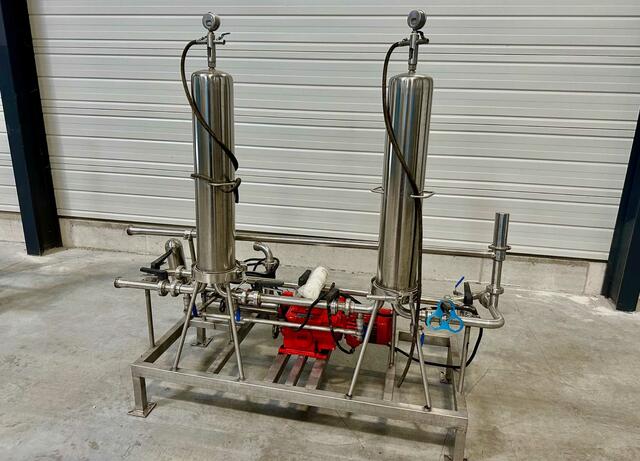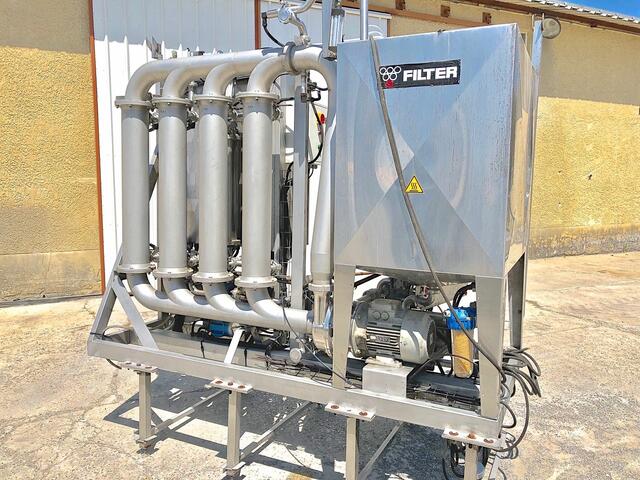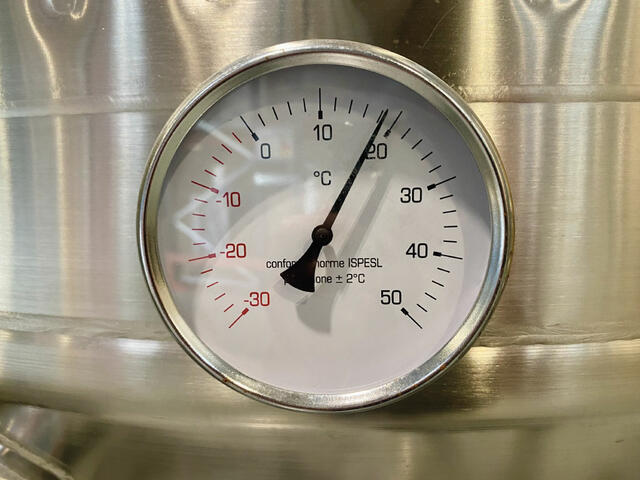Wine filtration : advanced techniques to optimise wine quality
Principles, processes and equipment for quality wine filtration
Wine filtration is a crucial process for ensuring the quality and clarity of wine before bottling. The filtration process plays a crucial role in wine production. It removes unwanted particles and improves the clarity and stability of the wine, while preserving its organoleptic characteristics. However, using filters can also be a real challenge for wine producers, as they have to find the subtle balance between filtration efficiency and preserving the quality of the wine. By choosing the right filtration techniques, such as gravity, vacuum or tangential filtration, producers can not only preserve the aromas and structure of the wine, but also maximise the efficiency of their production. In this article, we explore the different methods of wine filtration and best practices for maximising the quality of your wines.
→ Find out about used filters in stock
comparison of different wine filtration techniques
Wine filtration is a process designed to remove impurities and undesirable particles from the liquid. The ultimate aim is to clarify the wine so that it acquires optimum clarity, while preserving its organoleptic qualities. Filtration also stabilises the wine by eliminating micro-organisms that could alter its flavour and shelf life.
Gravity filtration
Gravity filtration is an ancient yet effective method used by wine producers to remove impurities and clarify their precious beverage. This traditional approach, although it may seem simple, is based on sound scientific principles that preserve the unique quality and flavours of wine. In this article, we dive into the world of gravity filtration, exploring how it works, its benefits and the types of filters that can be used to achieve outstanding results.
 |
 |
|
| Earth filter | Plate filter |
- How gravity filtration works
Gravity filtration relies on the natural force of gravity to move the wine through a filter. The process begins when the wine is gently poured into a container placed high up, often a barrel or raised tank. From there, the wine begins to flow downwards through a filter made of specific materials. These filters can be of different types, each with its own characteristics and advantages. - Types of filter used in gravity filtration
Cellulose filters : Cellulose filters are among the most commonly used in gravity filtration. They are made from natural cellulose fibres and offer effective filtration to remove unwanted particles while preserving the aromas and flavours of the wine.
Diatomaceous earth filters : Diatomaceous earth is a sedimentary rock rich in silica and diatom fossils. Diatomaceous earth filters are highly effective at removing fine particles and dead yeast, leaving the wine clear and limpid.
Plate filters : Plate filters use filter plates to retain solid particles in the wine. These filters are often used for larger volumes and offer rapid filtration.
- Advantages of gravity filtration
Preservation of the wine's characteristics : Gravity filtration is gentle and does not significantly alter the wine's components, thus preserving its unique organoleptic characteristics.
Natural process : By simply using gravity, gravity filtration avoids the use of artificial forces that are potentially damaging to the wine.
Low cost : This method of filtration is generally more affordable than some more advanced filtration technologies, making it a cost-effective choice for smaller producers.
Gravity filtration is a wine purification method that combines simplicity and efficiency. By letting gravity do its work through different types of filters such as cellulose, diatomaceous earth or plate filters, wine producers can achieve exceptional results without compromising the quality or unique characteristics of their wine. Whether you're a wine lover or a passionate wine producer, gravity filtration is a technique that is both traditional and modern, and well worth exploring to bring out the best in your wines.
Filtration sous vide
La filtration sous vide est une technique moderne et innovante qui offre aux producteurs de vin un moyen efficace de clarifier leur précieux nectar tout en préservant ses caractéristiques essentielles. Grâce à l'utilisation de la pression négative, cette méthode de filtration permet de retenir les particules indésirables, tout en évitant d'altérer la structure et les arômes du vin. Dans cet article, nous plongerons dans le monde de la filtration sous vide, découvrirons son fonctionnement, ses avantages et les types de filtres qui peuvent être utilisés pour obtenir des résultats remarquables.
 |
| Cartridge filter |
- How vacuum filtration works
Vacuum filtration is based on the principle of negative pressure. The wine is placed in a container, often a specially designed tank, and a filter is applied to the top. A vacuum pump is then used to create a negative pressure inside the container. This creates suction that gently pushes the wine through the filter, trapping unwanted particles and leaving the clarified liquid in the container. This method provides faster and more accurate filtration than gravity filtration. - Types of filter used in vacuum filtration
Cellulose membrane filters : Cellulose membrane filters are particularly suitable for vacuum filtration. They are designed to retain fine particles and dead yeast without altering the structure of the wine.
Polypropylene fibre filters : Polypropylene fibre filters are also commonly used for vacuum filtration. They offer high filtration efficiency while allowing good circulation of the wine.
Cartridge filters : Cartridge filters are easy to use for vacuum filtration. They are available in different pore sizes to meet the specific needs of the wine being filtered. - Advantages of vacuum filtration
Precise filtration : Vacuum filtration allows a clean separation of unwanted particles from the wine, providing maximum clarity without altering the composition of the liquid.
Preservation of aromas and flavours : By avoiding aggressive filtration, this method fully preserves the wine's distinct aromas and flavours.
Rapid treatment : Vacuum filtration is generally faster than other filtration methods, making it an ideal option for producers wanting an efficient production process.
Vacuum filtration is a significant advance in the world of winemaking, offering producers a precise and efficient means of clarifying wine without compromising its organoleptic qualities. With the right filters, such as cellulose membrane, polypropylene fibre or cartridge filters, winemakers can create exceptional end products that will appeal to the most discerning palates. Whether you're a passionate winemaker or a discerning amateur, vacuum filtration is an essential asset in perfecting the art of modern winemaking.
Tangential filtration
Cross-flow filtration, an advanced method of wine purification, embodies the perfect marriage between scientific precision and the preservation of wine's unique taste qualities. By using special membranes to filter the liquid, this technique offers unprecedented control over the filtration process, effectively removing unwanted particles while preserving the wine's essential compounds. In this article, we delve into the world of cross-flow filtration, discovering how it works, its benefits and the types of filter that enable winemakers to achieve excellence in their art.
 |
| Tangential filter |
- How cross-flow filtration works
Cross-flow filtration is based on the use of semi-permeable membranes that allow the wine to pass through while retaining unwanted particles. The wine is pushed along the surface of the membrane at a tangential angle, hence the name ‘tangential filtration’. Larger particles are thus rejected while the clarified wine flows through the membrane to be collected in another container. This method ensures precise filtration while preserving the aromatic compounds in the wine. - Types of filter used in cross-flow filtration
Ceramic membrane filters : ceramic membranes are renowned for their strength and durability. They offer precise filtration and can be cleaned and reused, making them an economical option for large-scale wine producers.
Polyethersulphone (PES) membrane filters : PES membranes are valued for their ability to filter fine particles while maintaining good permeability. They are particularly suitable for filtering delicate wines.
Polysulphone (PS) membrane filters : ps membranes are designed to offer excellent chemical and thermal resistance, making them suitable for a variety of wines and filtration conditions. - Advantages of cross-flow filtration
Preservation of wine characteristics : cross-flow filtration preserves the unique organoleptic characteristics of wine, preserving its distinct aromas and flavours.
Precise removal of unwanted particles : thanks to its precise filtration process, this method effectively removes unwanted particles while maintaining the clarity of the wine.
Flexibility for different types of wine : the different membranes available give producers the option of choosing the filter best suited to the specific characteristics of their wine.
Cross-flow filtration represents a major advance in the art of winemaking, enabling producers to bring out the best in their wines through precise, controlled filtration. With filter options such as ceramic, PES or PS membranes, wine artisans can create exceptional products, preserving the quintessence of their terroir and offering tasters an unforgettable sensory experience. Whether you're a passionate oenologist or a curious amateur, crossflow filtration is an indispensable tool for exploring new horizons in the fascinating world of wine.
Optimising efficiency without compromising quality
Each filtration technique has its advantages and disadvantages, and the choice depends on the style of wine required, its ageing potential and the winemaker's preferences. Over-filtration can rob the wine of its subtle aromas, while under-filtration can lead to instability and premature deterioration of the wine.
Choosing the right filter
Choosing the right filter is an essential step in the winemaking process. Each wine has its own specific characteristics and requirements in terms of clarification and purification. To achieve outstanding results, wine producers need to strike a subtle balance between filtration efficiency and preserving the wine's unique organoleptic qualities. In this article, we explore the importance of choosing the right filter, the criteria to consider and the types of filter that enable winemakers to bring out the best in their wines.
- The importance of making the right choice
Appropriate filtering plays a fundamental role in winemaking, as it enables the specific needs of each wine to be met. Inappropriate filtration can alter the composition of the wine, reduce its aromas or even lead to a loss of personality. On the other hand, the right filtration improves the clarity and stability of the wine, while preserving its identity and unique characteristics. - Criteria for choosing the right filtration
Type of wine : each type of wine (white, red, rosé, sparkling) has its own filtration needs due to its specific composition and distinct organoleptic characteristics.
Age of the wine : young wines may be more sensitive to aggressive filtration, while older wines often require a gentler approach to preserve their complexity.
Filtration objectives : producers need to clearly define the objectives of their filtration, whether it is to remove suspended particles, clarify the wine, or stabilise its colour.
Choosing the right filter is a crucial step in the winemaking process to bring out the unique characteristics of each wine. By taking into account the type of wine, its age and filtration objectives, producers can opt for the method and types of filter that maximise efficiency without altering the quality of the wine. Whether you're a passionate winemaker or a discerning connoisseur, finding this subtle balance will enable you to create exceptional wines that will delight the palates of connoisseurs around the world.
Controlling filtration parameters
Precise control of filtration parameters is a crucial step in the winemaking process to obtain an exceptional wine. Inadequate settings can compromise the quality and organoleptic characteristics of the wine, while a meticulous approach helps to fully preserve its identity. In this article, we take a look at the importance of controlling filtration parameters, the aspects to consider, and the types of filters that enable producers to sublimate the quality of their crus.
- The importance of control
The wine filtration process can be influenced by a number of parameters, such as pressure, flow rate and temperature. Careful control of these parameters is essential to obtain optimum results while avoiding undesirable effects on the wine. Precise management of filtration ensures effective clarification while preserving the wine's distinct aromas and flavours. - Key parameters to conside
Filtration pressure : the pressure applied to the filter has a direct impact on filtration speed. Too high a pressure can alter the structure of the wine, while too low a pressure can lead to a slow and inefficient filtration process.
Wine flow rate : the flow rate of wine through the filter must be controlled to avoid overloading or under-using the filter. A well-adjusted flow rate ensures even, efficient filtration.
Wine temperature : the temperature of the wine can influence its viscosity and chemical properties, which in turn can affect filtration. Careful temperature control ensures a stable and consistent filtration process.
Choosing the right filter is a crucial step in the winemaking process to bring out the unique characteristics of each wine. By taking into account the type of wine, its age and filtration objectives, producers can opt for the method and types of filter that maximise efficiency without altering the quality of the wine. Whether you're a passionate winemaker or a discerning connoisseur, finding this subtle balance will enable you to create exceptional wines that will delight the palates of connoisseurs around the world.

Carrying out filtration tests
In the winemaking process, carrying out filtration tests plays an essential role in obtaining an exceptional wine. Each wine is unique, and it is essential to adapt filtration to its specific characteristics. Filtration trials allow producers to test different methods and types of filter on small quantities of wine, in order to choose the optimum solution for clarifying and preserving the quality of the precious beverage. In this article, we'll delve into the art of filtration trials, discover their benefits, and explore the types of filters that can be used to bring out the best in your wine.
- The benefits
Customised filtration : every wine has its own particularities, and filtration trials allow you to tailor the process to its specific composition and needs.
Optimisation of settings : the tests enable filtration parameters such as pressure, flow rate and temperature to be fine-tuned for optimum results.
Risk prevention : by carrying out tests on small quantities of wine, producers can avoid costly errors on larger volumes. - Stages of filtration trials
Filter selection : choose the appropriate types of filter according to the characteristics of the wine to be filtered and the filtration objectives.
Adjustment of parameters : adjust filtration parameters such as pressure, flow rate and temperature for each test.
Preliminary tests : carry out tests on small quantities of wine to assess efficiency and impact on wine quality.
Filtration testing is an essential step in enhancing the quality of your wine. By customising the filtration process through trials on different types of filter, producers can optimise the settings for each wine and preserve its distinct characteristics.Whether you are an experienced winemaker or a passionate amateur, the art of filtration testing will enable you to magnify the perfection of your beverage, offering unforgettable tastings that will seduce the palates of wine lovers the world over.
faq on wine filtration
- What is wine filtration and why is it important ?
Wine filtration is a process used to clarify wine by removing impurities, solid particles and micro-organisms. It is essential to guarantee the wine's stability, clarity and quality before bottling. - What are the main filtration techniques used in winemaking ?
The most common techniques include gravity filtration, vacuum filtration and cross-flow filtration. Each has its advantages: gravity filtration is gentle and preserves aromas, vacuum filtration is effective at removing fine particles, and crossflow filtration is ideal for a continuous process without clogging. - How do you choose the filtration technique best suited to your wine ?
The choice of technique depends on the type of wine, its level of turbidity, and the filtration objectives. For example, for robust red wines, gravity filtration might be preferable to preserve the tannins, while for delicate white wines, tangential filtration would offer better clarity without altering the flavours. - Does filtration affect the taste of the wine ?
Filtration, when carried out correctly, does not adversely affect the taste of the wine. On the contrary, it can improve quality by eliminating undesirable elements while preserving the wine's aromas and structure. - How can the wine filtration process be optimised ?
To optimise filtration, it is crucial to choose the right method, to prepare the wine properly before filtration (screening, settling), and to ensure rigorous monitoring of filtration parameters. The use of modern, well-maintained equipment is also essential for an efficient process. - What are the costs associated with wine filtration ?
Costs vary according to the technique used, the equipment required and the quantity of wine to be filtered. Sophisticated techniques such as crossflow filtration may be more expensive in terms of initial investment, but they offer advantages in terms of efficiency and durability.
Wine filtration is an essential pillar in the wine production process, ensuring both clarity and quality in every bottle. By understanding the different filtration techniques - whether gravity, vacuum or cross-flow - and optimising each stage, producers can not only preserve aromas and flavours, but also improve the efficiency of their production. Integrating methods adapted to your type of wine and implementing an optimisation strategy are key factors in achieving excellence. By staying at the cutting edge of technological innovation and choosing the right equipment, you can maximise the quality of your wines while boosting your winery's profitability.
Investing in optimised wine filtration means contributing to the success of your winemaking and the satisfaction of your customers. Whether you're a small producer or a large estate, the advantages of well-controlled filtration are numerous and decisive for standing out in an increasingly demanding market.
#filtre #vinicole #filtration #vin #diatomee #tangentiel #cartouche #techniques





